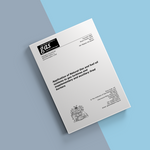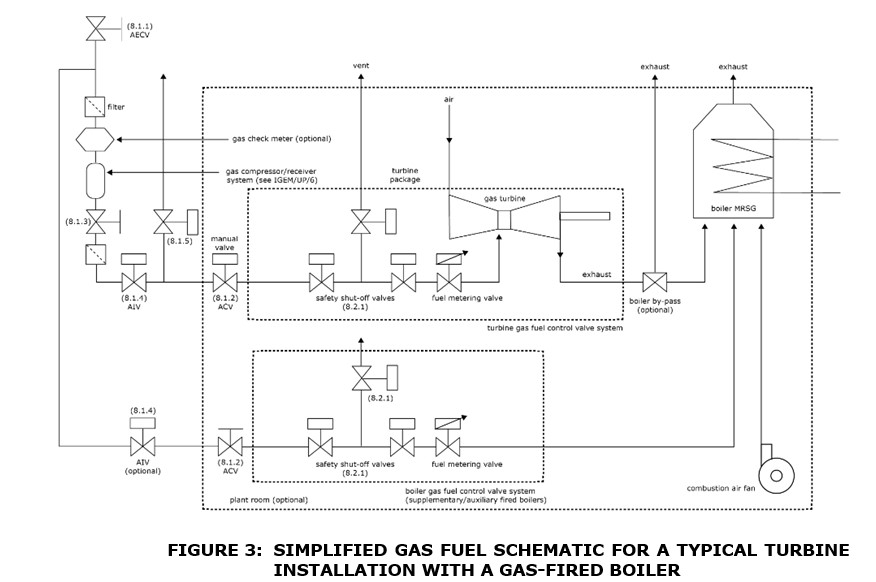IGEM/UP/9 Edition 3 - Application of Gas systems to gas turbines and supplementary and auxiliary fired burners

The IGEM/UP/9 standard covers the essential safety aspects of the engineering, start-up, operation and shut-down of gas turbines and associated equipment/
This Standard refers primarily to gas turbines using lighter and heavier than air flammable fuel gases such as Manufactured Gas, Natural Gas (NG), Liquefied Petroleum Gas (LPG), LPG/air mixtures, (1st, 2nd and 3rd family gases are further defined in BS 1179). They may be appropriate for other non-conventional gases such as Landfill, Anaerobic Digester and Mines Recovery Gas and Hydrogen, but the particular characteristics of the gas needs to be recognised with respect to consequent effects on materials and operations.
This Standard applies to gas turbines for continuous and standby duties, for example in industrial and commercial sites for combined heat and power (CHP), power generation and gas compression systems. Turbines used for vehicular propulsion or used offshore are not covered. However, the general principles outlined in this Standard may be used as guidance. It may also be a useful reference for gas engineers. This document provides guidance on the safe use of gas in an educational establishment. It provides an accessible guidance on the regulatory aspects of the parent document IGEM/UP/11, “Gas installations in educational establishments”.
Introduction
1.1 This Standard supersedes IGEM/UP/9 Edition 2, Communication 1705, which is obsolete.
1.2 This Standard has been drafted by an Institution of Gas Engineers and Manager (IGEM) panel, appointed by IGEM’s Gas Utilisation Committee and has been approved by IGEM’s Technical Coordinating Committee on behalf of the Council of IGEM.
1.3 This Standard covers the application of fuel gas supply to gas turbines and the exhaust gas interaction with supplementary and auxiliary fired burners.
1.4 The development and application of gas turbines as efficient and reliable power sources is well proven throughout the world. The high temperature of the exhaust gases and its ability to support combustion of additional fuel with supplementary and auxiliary firing, has led to considerable use of turbines in conjunction with waste heat recovery equipment such as boilers, dryers, etc. The rapid start up process enabling turbines to accept full load from a “cold start”, and their very high power to weight ratio, has popularised their use as power generation.
1.5 In contrast to other types of gas burners, the start up, operation, and shut down procedures employed on a turbine are determined by many more factors than merely the need to establish, maintain and control a stable flame. In particular, the inter-dependence of turbine power and combustion air supply, the need to reach a self sustaining speed rapidly to reduce the depletion of any starter motive power supplies, the avoidance of critical shaft or blade aerofoil resonance, and the very rapid flame modulation needed to handle the sudden acceptance and shedding of loads, impose severe restrictions. These restrictions render many of the practices common on other large gas burners impracticable in this application. The high excess air quantities also provide considerable scope for safe deviation from practices used on other burners.
1.6 For gas firing, it is vital to consider the system as a whole, including the Gas Transporter (GT)’s network, the Meter Equipment Manager’s (MEM’s) meter installation, installation pipework, fuel gas compressor, turbine, supplementary/auxiliary fired burners and other gas users on site. Although generally Natural Gas (NG) is dry, other gases may contain varying levels of moisture and contaminants which will be considered at the design stage.
1.7 The ignition and subsequent operation of gas and dual-fuel burner systems for supplementary firing are covered by IGEM/UP/12, and BS EN 746 Part 2 as appropriate.
1.8 This Edition of the Standard no longer covers the requirements for gas turbines being supplied by fuel oil.
1.9 This Standard makes use of the terms ‘‘must’’, ‘‘shall’’ and ‘‘should’’ when prescribing particular requirements. Notwithstanding Sub-Section 1.10:
(a) The term ‘‘must’’ identifies a requirement by law in Great Britain (GB) at the time of publication.
(b) The term ‘‘shall’’ prescribes a procedure which it is intended, will be complied with in full and without deviation.
(c) The term ‘‘should’’ prescribes a procedure which it is intended, will be complied with unless after prior consideration deviation is considered to be acceptable.
Such terms may have different meanings when used in Legislation, or Health and Safety Executive (HSE) Approved Codes of Practice (ACoPs) or Guidance, and reference needs to be made to such statutory Legislation or official Guidance for information on legal obligations.
1.10 Notwithstanding Sub-Section 1.9, this Standard does not attempt to make the use of any method or specification obligatory against the judgement of the responsible engineer. Where new and better techniques are developed and proved, they ought to be adopted without waiting for modification to this Standard. Amendments to this Standard will be issued when necessary, and their publication will be announced in the Journal of IGEM and other publications as appropriate.
1.11 It is now widely accepted that the majority of accidents in industry generally are in some measure attributable to human as well as technical factors. People who initiated actions that caused or contributed to accidents might have acted in a more appropriate manner to prevent them.
To assist in the control of risk and proper management of these human factors, due regard ought to be taken of HSG48 and HSG65.
1.12 The primary responsibility for compliance with legal duties relating to health and safety at work rests with the employer. The fact that certain employees, for example ‘‘responsible engineers’’, are allowed to exercise their professional judgement does not allow employers to abrogate their primary responsibilities.
Employers need to:
• have done everything to ensure, so far as is reasonably practicable, that there are no better protective measures that can be taken other than relying on the exercise of professional judgement by ‘‘responsible engineers’’
• have done everything to ensure, so far as is reasonably practicable, that ‘‘responsible engineers’’ have the skills, training, experience and personal qualities necessary for the proper exercise of professional judgement
• have systems and procedures in place to ensure that the exercise of professional judgement by ‘‘responsible engineers’’ is subject to appropriate monitoring and review
• not require ‘‘responsible engineers’’ to undertake tasks which would necessitate the exercise of professional judgement that is not within their competence. There should be written procedures defining the extent to which ‘‘responsible engineers’’ can exercise their professional judgement. When ‘‘responsible engineers’’ are asked to undertake tasks which deviate from this they should refer the matter for higher review.
1.13 Requests for interpretation of this Standard in relation to matters within their scope, but not precisely covered by the current text, ought to be either:
• addressed to Technical Services, IGEM, IGEM House, 26 & 28 High Street, Kegworth, Derbyshire, DE74 2DA; or
• emailed to [email protected].
These will be submitted to the relevant Committee for consideration and advice, but in the context that the final responsibility is that of the engineer concerned. If any advice is given by or on behalf of IGEM, this does not imply acceptance of liability for the consequences and does not relieve the responsible engineer of any of his or her obligations.
1.14 Terms such as “maximum operating pressure” (MOP), “maximum incidental pressure” (MIP), “operating pressure” (OP), “lowest operating pressure” (LOP) and “design minimum pressure” (DmP) were introduced in IGEM/UP/2 to reflect
gas pressure terminology used in European standards.
Other terms were introduced to assist in recognition of design information to be transferred between interested parties.
Referring to Figure 1, attention is drawn to how OP oscillates about the set point (SP). Note also that MOP can be declared at a higher value than OP. The strength test pressure (STP) has to exceed MIP. This means that, at least with respect to integrity, the installation will withstand a fault pressure from the upstream system. Safe operating limit (SOL) is a requirement of the Pressure Systems Safety Regulations (PSSR) (where applicable).
1.15 This Standard was published in December 2022.
Scope
2.1 This Standard covers the essential safety aspects of the engineering, start up, operation, and shut down of gas turbines and associated equipment (typical arrangements are shown in Figures 2 and 3). They are not intended to provide a complete specification for such equipment.
2.2 This Standard refers primarily to gas turbines using lighter and heavier-than-air flammable fuel gases such as Manufactured Gas, Natural Gas (NG), Liquefied Petroleum Gas (LPG), and LPG/air mixtures (1st, 2nd and 3rd family gases are further defined in BS 1179 (withdrawn)). They may be appropriate for other non-conventional gases such as Landfill, Anaerobic Digester, and Mines Recovery Gas and Hydrogen, but the particular characteristics of the gas need to be recognised with respect to consequent effects on materials and operations.
2.3 This Standard applies to gas turbines for continuous and standby duties, for example in industrial and commercial sites for combined heat and power (CHP), power generation, and gas compression systems.
Turbines used for vehicular propulsion or used offshore are not covered. However, the general principles outlined in this Standard may be used as guidance.

2.4 This Standard applies to:
- both single and multi-shaft turbine types
Note: In this context, “shaft” relates to the turbine and not to the alternator. The term “spool” is a commonly used alternative.
- both single and multiple burner types
- turbines exhausting to heat recovery equipment, with or without supplementary and/or auxiliary-fired burners, which may or may not have air supplies other than the engine exhaust. Those having independent air supplies are also considered as auxiliary fired.
2.5 This Standard applies to gas turbines supplied directly from a gas supply and to those supplied via a gas compressor.
Note: Requirements for gas compressors are provided in IGEM/UP/6.
2.6 Metric standard conditions apply, unless otherwise specified.
2.7 All pressures are gauge pressures, unless otherwise stated.
2.8 All fuel inputs are given net, unless otherwise stated.
2.9 The term “turbine(s)” refers to “gas turbine(s)” throughout, unless otherwise stated.
2.10 Italicised text is informative and does not represent formal requirements.
2.11 Appendices are informative and do not represent formal requirements unless specifically referenced in the main sections via the prescriptive terms “must”, “shall” or “should”.
